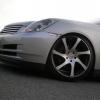Go Fully sealed or 1/2 enclosed for sub?
Announcements
-
Similar Content
-
Latest Posts
-
You know what? I reckon you're on to something.
-
By Murray_Calavera · Posted
Sounds like doing a track day will resolve all your issues. -
The rotors only have about 5k on them so I didn't worry about the machining.
-
Also, if you didn't machine or replace rotors, it will make it harder to bed the new pads properly. It is something I'll advised to do. And yes, I've done it many times before, and will likely do it again, so no judgement here if you didn't replace or machine the rotors.
-
Yeah, you need to do it properly. You need to start out slow and gentle, ramping it up until they are good and hot, but not cooking, then roll off the other side (instead of letting them cool down quick).
-







Recommended Posts
Create an account or sign in to comment
You need to be a member in order to leave a comment
Create an account
Sign up for a new account in our community. It's easy!
Register a new accountSign in
Already have an account? Sign in here.
Sign In Now